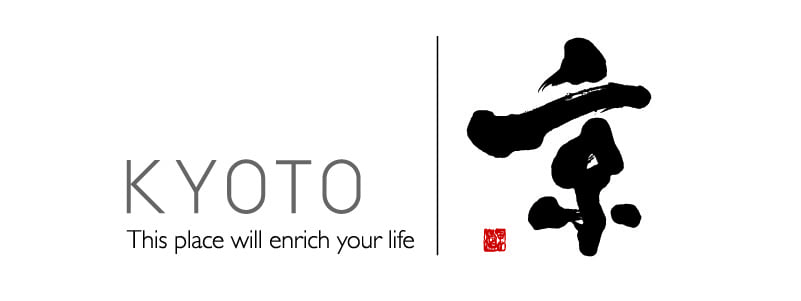Term archive
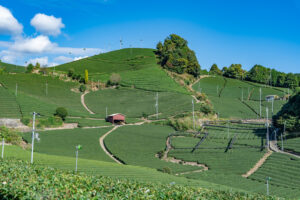
投稿タイプ:sightseeing
Shirasu and Ishitera Tea Plantations
Wazuka Town gradually warms up from west to east in spring. In Ishitera and nearby places, located in the western part of Wazuka, tea picking begins no later than late April. Therefore, the tea plantations in this area are called Hayaba (place of early harvest).
The tea plantations in Shirasu and Ishitera, cultivated with modern methods of agriculture, present beautiful scenery. The tea fields carpet the mountain slopes, forming breathtaking panoramas. In Ishitera, you can enjoy a stunning view of the tea fields that seem to kiss the sky. When you gaze up at the diminutive peak, the surprising vista reveals itself.
These places are a part of tea plantations registered as the first Scenic Assets of Kyoto Prefecture. They are also a part of the Japan Heritage (Japanese Tea: Eight Centuries of Tradition).
As a side note, you can rent an electric bicycle at Wazukacha Cafe and enjoy cycling in Wazuka. Enjoy the town's landscapes and natural scenery. (The tea plantations are private property. Please do not enter them.)
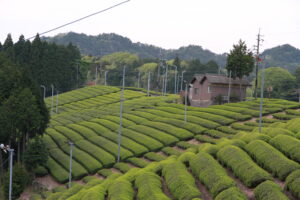
投稿タイプ:sightseeing
Dousenbou Nagano Tea Plantation
Minamiyamashiro Village is Kyoto's only village. Approximately 80% of the village is mountainous, with elevations ranging from 300 to 600 meters. This unique topography led to the development of the slopes for tea cultivation.
Nestled amidst the mountains at an altitude of about 500 meters, Dousenbou is a hamlet in the flatlands that was born in the Meiji Period (1868-1912). The tea plantation owes its prosperity to the bustling tea trade on Kizu River.
Today, you can still appreciate the timeless beauty of the tea fields, combined with rice paddy fields. The tea fields spread along the mountain slopes, which is an impressive sight that will stay with you. This characteristic landscape offers a glimpse into the interplay between the history of modern Uji tea production, and this area's unique environment and cultivation practices.
As a side note, the village has several cycling routes. Enjoy the village's landscapes and natural scenery. (The tea plantations are private property. Please do not enter them.)
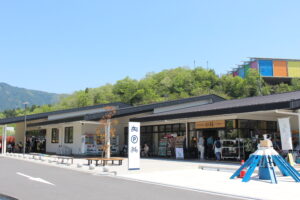
投稿タイプ:sightseeing
Roadside Rest Area Ocha-no-Kyoto Minamiyamashiro Village
This rest area encapsulates the wonderful everyday life of Minamiyamashiro Village. You can immerse yourself in the village life and discover their traditional wisdom through eating, drinking and so on.
They sell a wide variety of local specialties, including tea and fresh vegetables at the market called Nomon Ichiba. Delicious tea sweets would make great gifts for your loved ones.
You can savor genuine tea with ease on the spot, at the sweets and tea shop, Muracha-ya. Their soft serve made with the village’s high-quality matcha green tea is famous for its authentic flavor. The rich matcha syrup poured on it is amazing, too. You can enjoy the beautiful balance of sweetness and pleasurable bitterness. (430 yen, tax included.)
This rest area also has Murafudo Shokudo Tsuchi-no-Ubu, a cozy place where you can relax and enjoy a delicious meal. Savor their dishes incorporating tea. They have delicious ones modeled after the local villagers' meals.
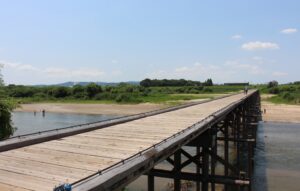
投稿タイプ:sightseeing
Nagarebashi (Kouzuyabashi)
Nagarebashi, officially known as Kouzuyabashi, is a 356.5-meter-long bridge crossing the Kizu River. It is one of the longest wooden bridges in Japan. The name "Nagarebashi" means "a flowing bridge" in English. Sometimes the river experiences a significant water level rise by heavy rain, especially in a typhoon season. Instead of resisting the water flow, the bridge is designed to flow along with it. Of course, it’s not completely washed away. Its walkway naturally gets separated into several parts, and they drift apart from the bridge and float on water, but they’re connected to the bridge piers by wire ropes, actually. To return the washed-away parts to their original positions on the piers, you can pull up the ropes. This is a bridge that adapts to the natural conditions around the river, rather than resisting them.
The wooden bridge has a charming and nostalgic atmosphere. It has been used as a filming location for many historical films and TV shows.
Right beside the bridge, you can see tea plantations. It’s a great place where fertile soil is naturally carried by the river. This area is famous for producing high-quality tea. To ensure the safety of residents, the embankment was strategically constructed to circumvent the tea plantations. It’s a wonderful place to feel the culture of Yawata. The Nagarebashi and the surrounding tea plantations are a part of the Japan Heritage (Japanese Tea: Eight Centuries of Tradition), certified by the Agency for Cultural Affairs.
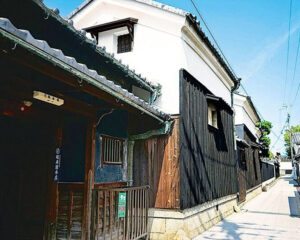
投稿タイプ:sightseeing
Kamikoma Tea Wholesaler District
The Yamashiro area, located in the southern part of Kyoto, is famous for its tea. In and around the Kamikoma area, southern Yamashiro, tea cultivation dates back to the Muromachi Period (1336-1573).
In 1868, Port of Kobe (Hyogo Port) opened, which revolutionized the tea industry. With the exports from the port, tea production skyrocketed. Tea leaves from this and surrounding areas were transported here, and processed by tea merchants. They were then shipped to the port via Kizu River and Yodo River for export overseas.
This area flourished as a tea wholesaler district.
Even today, there remain about 40 tea wholesalers. You can also see a monument of the tea industry of Yamashiro. Take a leisurely stroll and enjoy the quaint atmosphere, feeling the history and tradition.
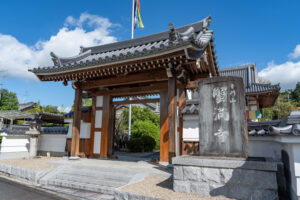
投稿タイプ:sightseeing
Kanimanji Temple
While the exact origins of Kanimanji Temple are shrouded in mystery, it is estimated to have been founded in the end of the Hakuho Period (around 645-710). Larger than it is today, the temple was initially referred to as Kabata-tera in ancient documents.
Its principal image, a colossal 2.2-ton sitting statue of Shaka Nyorai, is a designated National Treasure and a masterpiece surviving from the temple's founding.
The temple is renowned for the story, Kani no Ongaeshi (Crab's Return of a Favor) in the Konjaku Monogatari (Tales of Times Now Past). The story goes as follows:
One day, a young lady who was a devout believer in Kannon (Avalokiteśvara) Bodhisattva saved a crab that was being bullied by villagers. Later, Kannon transformed into a crab and saved her from a terrible fate. Filled with reverence and gratitude, she and her father built the temple to enshrine the crab.
Even now, a crab-releasing festival is held at this temple every year on April 18th.
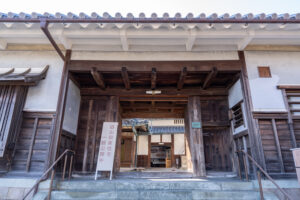
投稿タイプ:sightseeing
The Original Yamada Residence
In the Edo Period (from 1603 to around 1868), the Yamada family served as O-shoya (the head of a local community, who managed the people) of thirteen villages in the area called Mimaki-go. They managed the fishing operations around Ogura-ike Pond that once spread over a large area.
Their residence was strategically built on the stone foundation to protect it from flooding. The nagaya-mon (one of Japanese traditional gatehouse styles) at its entrance, with its imposing appearance reminiscent of a Buke-Yashiki (samurai house), offers a glimpse into the family's former status. The nagaya-mon, the long wall and the main house inside are nationally-registered Tangible Cultural Properties.
You can also see materials related to the Ogura-ike Pond inside. There is an exhibit of traditional fishing tools, including traps and a boat-shaped fish tank as well. The remaining carp-designed ranma (decorative panel seen in the upper part of a room) and a dragon painting on fusuma (Japanese sliding partition) still exude the family’s grandeur.
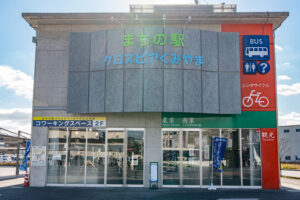
投稿タイプ:sightseeing
Machinoeki Crosspeer Kumiyama
Machinoeki Crosspeer Kumiyama has a bus terminal and a waiting lobby for bus passengers. It’s also used as a public space where people can relax and interact.
They sell local specialties, including fresh local vegetables, food processed in and around the town, and more. A variety of breads are one of the facility’s attractions.
The second floor can be used for meetings, coworking, socializing and other activities.
Electric bicycle rental is available, too. (This is a great place to begin a cycling tour of the town.)
The facility serves as a hub for disseminating information about local industries, facilitating collaboration among local businesses, and so on.
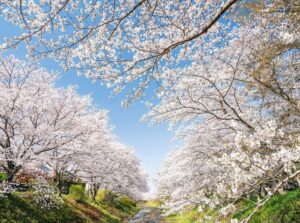
投稿タイプ:sightseeing
Cherry Blossoms Along Tama River
Tama River, located in Ide Town, is a wonderful hanami (cherry-blossom viewing) spot. Cherry trees form elegant rows for approximately 1,500 meters along both banks of the river, and amazing tunnels of cherry blossoms appear in the spring (around late March and early April). In this season, a festival is held to celebrate the fascinating sight. You can even experience the magic of the blossoms illuminated at night.
The gentle flow of the river provides a peaceful atmosphere. It’s a perfect place for families to unwind and enjoy the beauty of nature. It’s also fun to imagine how it was a long time ago when the gentle murmur of waterwheels accompanied the daily lives of people living around the river. Also, adults and children alike can enjoy crossing the river by hopping across the stepping stones.
Tama River is so clear that it is one of the "Selected 100 Exquisite and Well-conserved Waters" of the Heisei Era (1989-2019). Since ancient times, the river has been woven into artworks such as famous poetry, stories and so on.
In this area, you can also see early-blooming cherry blossoms at Ide Town Machizukuri Center Tsubakizaka, and an about 300-year-old cherry tree at Jizozen-in Temple.
Around the Tama River, following the beauty of somei-yoshino (the most popular variety of sakura), yamabuki (Japanese kerria, also known as Japanese rose) flowers bloom, dyeing the surroundings a beautiful rich yellow.
In early summer, you can see fireflies around the river (near Tamamizu Station), too.
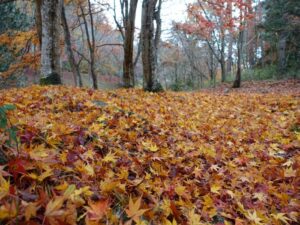
投稿タイプ:sightseeing
Yamashiro Forest Park
This forest park is blessed with abundant nature in all seasons, but offers especially beautiful spots for viewing the colorful autumn leaves. Enjoy a panoramic view of the Soraku area from the Mt. Sanjoyama Observatory in the park.
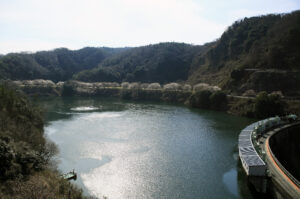
投稿タイプ:sightseeing
Takayama Dam
The dam was constructed in Minamiyamashiro Village in 1968 and began operation the following year. It’s 67 meters high, and stretches approximately 209 meters in length. It has six emergency gates that can be opened simultaneously to flush the water.
With abundant nature, this area is a good destination for driving and hiking. In the spring, you can see beautiful cherry blossoms. Around the middle of the dam’s reservoir, there is Tsukigase Baikei (Tsukigase Plum Valley) that is one of the “Places of Scenic Beauty” of Japan. It’s famous for its amazing plum blossoms. Uniquely, the reservoir spans across three prefectures: Kyoto, Nara, and Mie. Nearby, you can also find Tayama Tsurugi Tea Plantation. Recognized as a part of the Japan Heritage, it presents a culturally significant landscape.
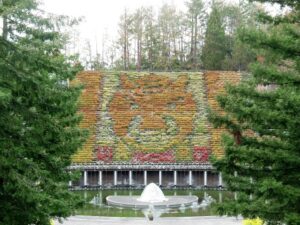
投稿タイプ:sightseeing
Uji City Botanical Park
Uji City Botanical Park opened in October 1996. The spacious grounds, spanning approximately 10 hectares, feature a varied landscape with undulating terrain, a fountain, a pond, and streams that create beautiful scenery together with the plants.
The large-scale multi-level flower bed, Tapestry of Flowers and Water, is the largest in Japan, offering an impressive sight measuring 62 meters in width and 18 meters in height. 3,675 planters are arranged on the 46 tiers of the grand platform at the waterside, depicting characters and other themes related to Uji, seasonal motifs, and so on.
On the southwest (left) side of the park lies the Spring Zone, where cherry blossoms and various other flowers bloom. The weeping cherry blossoms are particularly popular, reaching full bloom around late March, and the nightly light-up (free of charge) is eagerly anticipated by many people every year. Visitors can enjoy the stunning view with the city nightscape.
In summer, fireflies can be seen around a stream. Additionally, the Summer Zone offers a display of lotus flowers, which once flourished on Ogura-ike Pond that once existed.
The northeast (right) side of the park boasts the Fall Zone, where visitors can admire beautiful fall foliage.
The greenhouse provides an environment to enjoy tropical and subtropical plants throughout the year, along with the waterfall.
